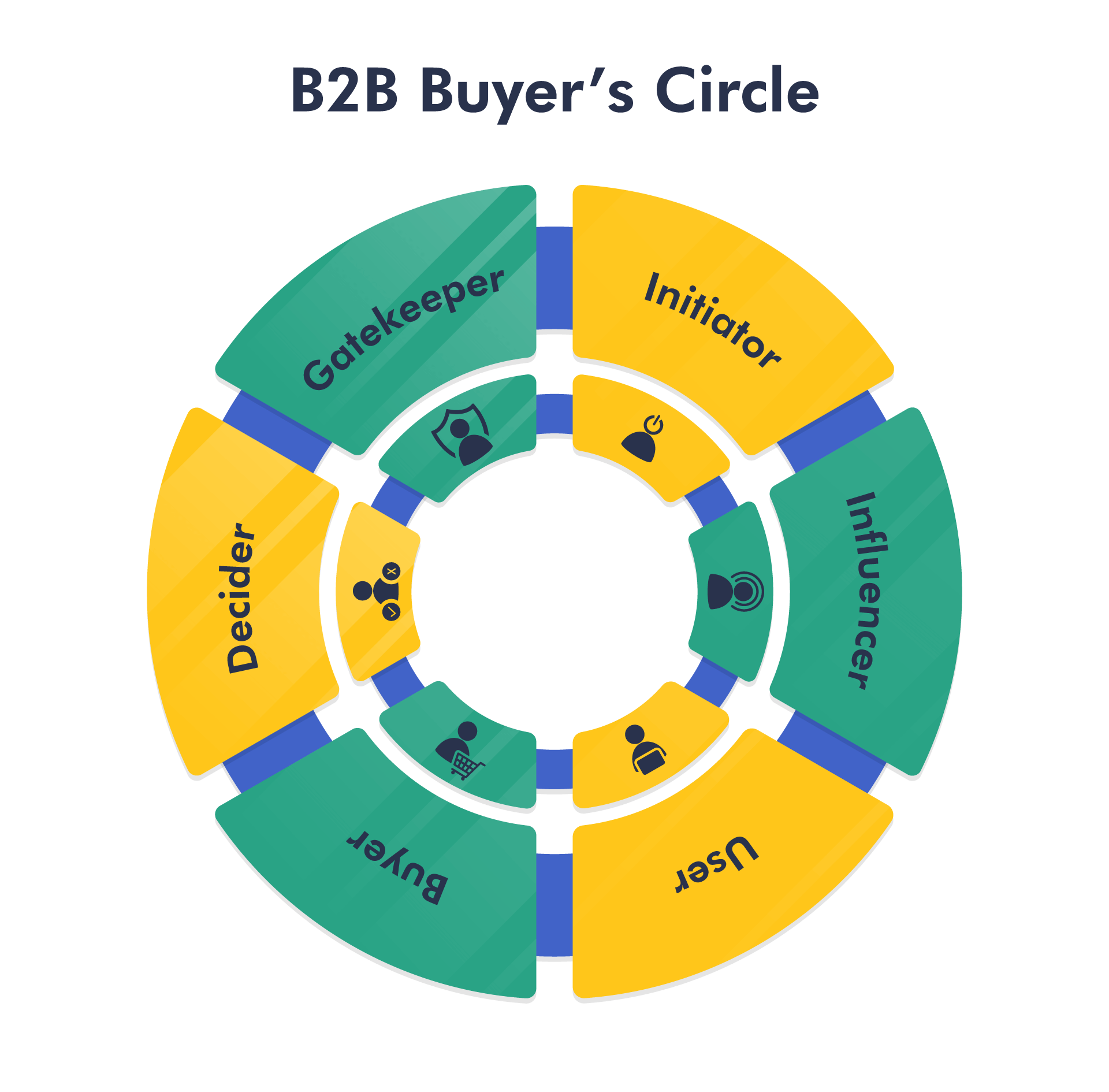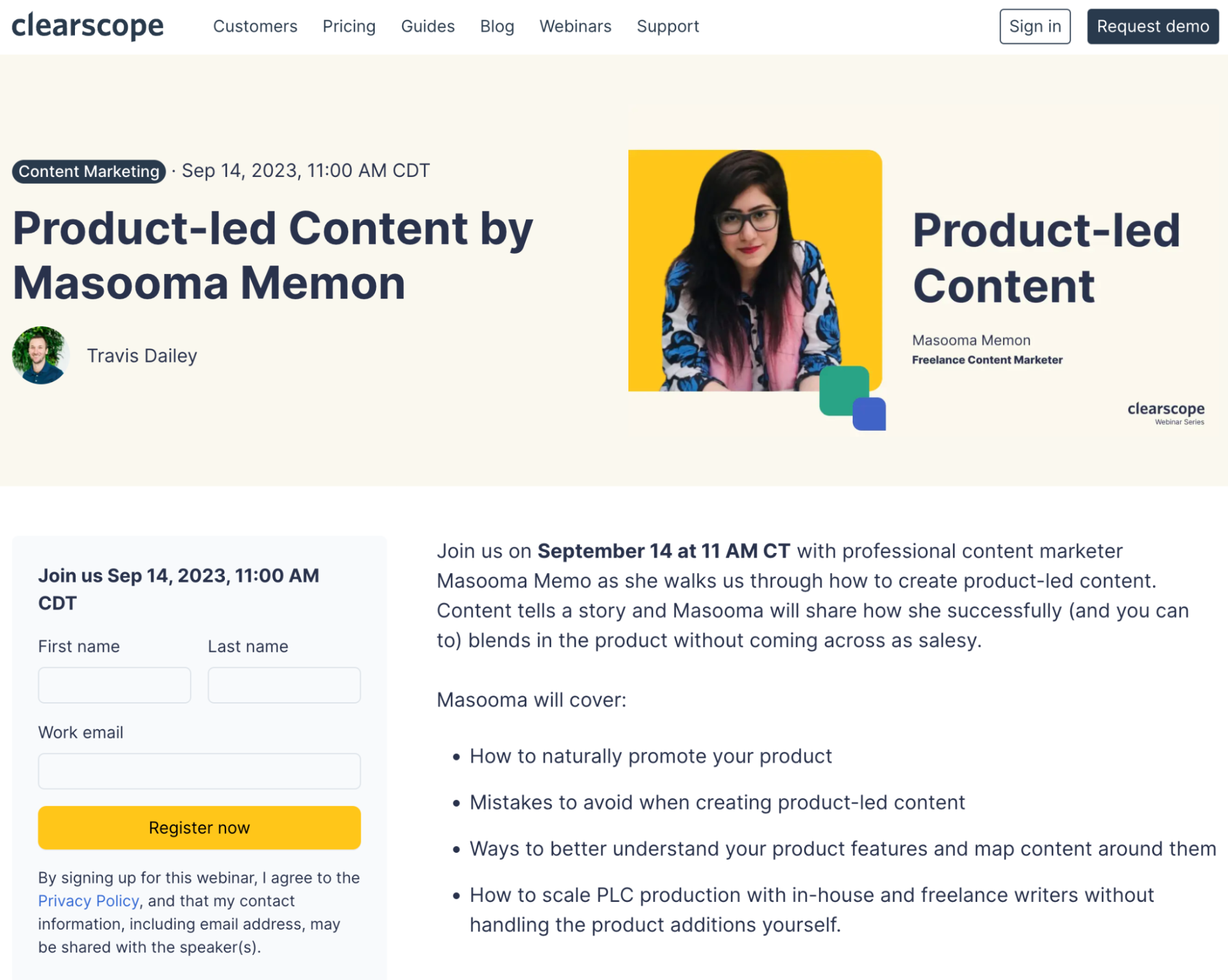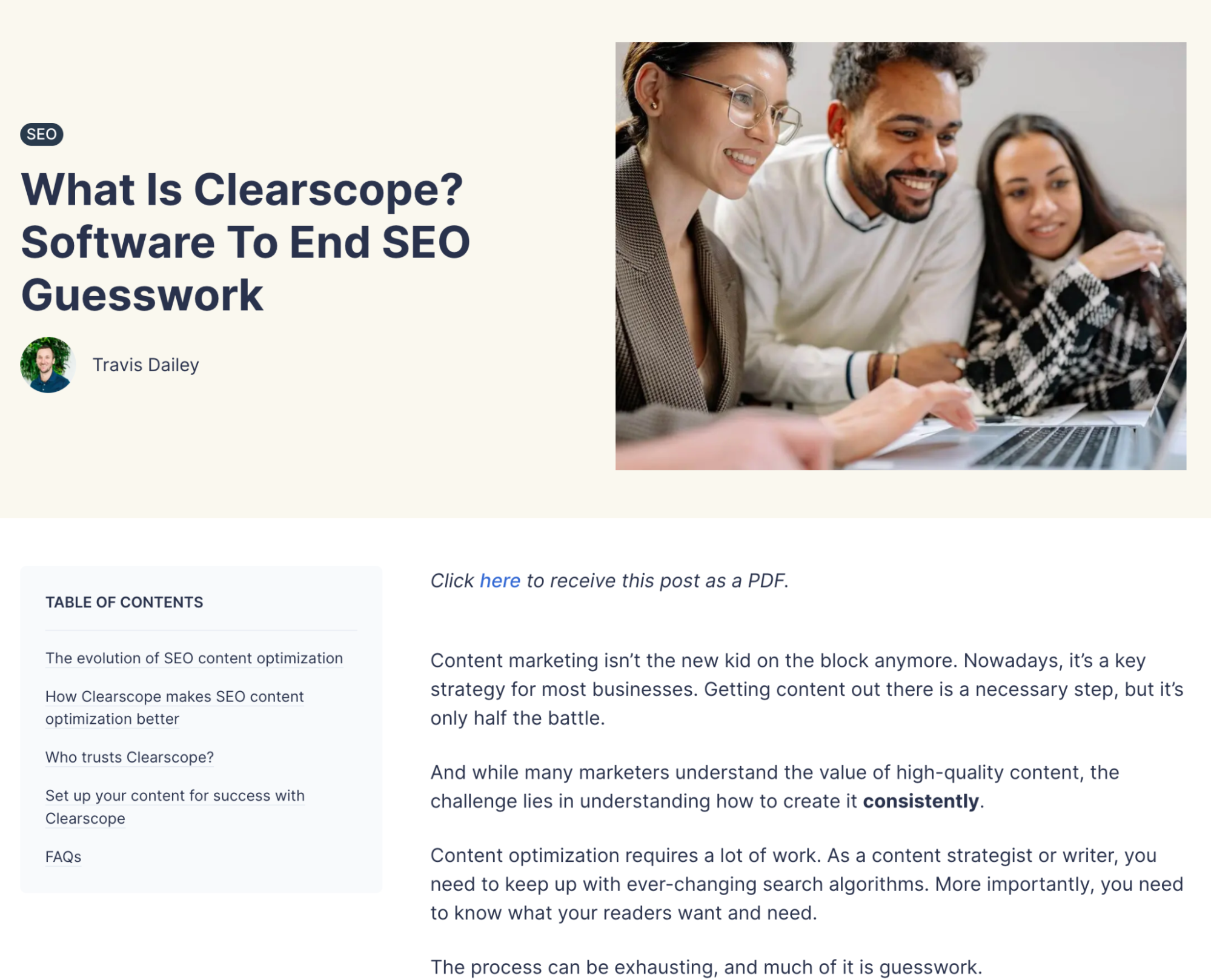B2B Content Marketing Strategy: Steps to a Winning Strategy
Topic: Content Marketing
Published:
Written by: Bernard Huang
Elevate your business above competitors with a winning content marketing strategy.
An effective content marketing strategy goes beyond just a blog.
It’s a cohesive multi-channel and medium message. It’s how you share who you are as a business and why you’re special.
We’ll dig into what makes a B2B content marketing strategy and how you can create (or update) one.
Let’s jump into it.
Why is a B2B content strategy important?
A content marketing strategy attracts new customers and assures your existing customers they made the correct decision going with you.
It’s how you share why your business exists, what you stand for, and what you’re building.
Plus, content has a long life span especially when compared to a paid ad. And studies show that buyers in B2B businesses (business-to-business) consider content a key decision-making factor.
Focus your efforts on creating high quality content, not just content.
By creating content that resonates with your audience, you can expect:
Earn organic search rankings that deliver your audience to your website
Earn backlinks from reputable websites that drive traffic and send positive signals to search engines
Increase social media shares that builds brand awareness
Build trust with your customers and prospects
Educate the market about your offering
Establish your brand in the industry
B2B content marketing vs. ecommerce content marketing
Content marketing focuses on educating your audience, building trust, and providing value.
Ecommerce success, on the other hand, relies heavily on cross-platform marketing, paid advertisements, and ease of use. According to Kantar, 66% of buyers listed convenience as the reason they chose their retailer.
In short, B2B content marketing strategies focus heavily on long-term relationship growth. In contrast, ecommerce content marketing is geared toward transactions.
B2B content types
A thorough B2B content marketing strategy usually has a marketing mix that includes several different content types aimed at your B2B audience.
Specific content types support different stages of the B2B buyer circle (pictured below) and customer journey.
Keep this in mind when planning out the type of content to create.

The B2B buyer’s circle.
There are six main content types:
Webinars
E-books
White papers
Research and survey reports
Blog posts
Case studies
Let’s take a closer look at each of the top B2B content types.
Webinars
A webinar is a virtual presentation with an online audience that can be held live or replayed on-demand. Live webinars enable audience interaction through chat features and Q&A sessions.
Webinars are useful for helping existing customers get the most out of your product and introducing your solution to potential leads.
According to the Demand Gen Content Preferences report, buyers find webinars most helpful at the early stage (49%) and middle (38%) of the buying process.

RSVP page for a Clearscope webinar.
Popular webinar formats include:
Industry trend presentations
Expert panels
Tutorials
We host a weekly webinar with the marketing industry’s best and brightest. Topics range from strategy to content marketing to SEO. Watch replays of previous webinars here.
E-books
E-books are online books that typically answer a “how-to” question for your readers. Content marketers often distribute e-books for download on a landing page built for lead generation.
The content in e-books is usually targeted to a specific person in the buyer persona to help them become better at their job. And they are often useful at the top of the funnel when the prospect is researching the problem they are solving.

Content-Led SEO playbook from Demand Curve and Clearscope.
Unlike white papers and long-form blog posts, e-books combine text with compelling visuals that help make complex topics easier for your audience to understand.
White papers
White papers are in-depth informational documents that explore a specific problem and advocate for a solution.
While they may also include “how-to” information like an e-book, white papers are more academic in their exploration of a problem. And they’re often more concentrated on a specific issue.

“Securing DevOps Enterprise Environments” white paper.
White papers typically don’t sell a product. Instead, they argue why one methodology or approach is best for the particular problem.
White papers are most helpful for readers at the top of the funnel who are still exploring the issue and comparing potential types of solutions.
Blog posts/articles
Blog posts and articles often play a central role in a brand’s search engine optimization or SEO content strategy. Marketers use them to capture real estate on Google’s search engine results pages (SERPs) and drive organic traffic to their websites.

What is Clearscope? blog post.
B2B blogs can feature other kinds of content, such as case studies. Other frequently used blog formats for organizational buyers include:
How-tos
Industry trends
Product/company updates
Expert interviews
Research and survey reports
Data reports are documents that you publish summarizing findings and recommendations based on your own research.
Publishing and distributing these reports give your readers access to valuable data-driven insights without needing them to do the heavy lifting involved with surveys and data analysis.
Annual industry or benchmark reports help you provide real value while establishing your brand expertise and authority.

Content Marketing Trends report from Siege Media and Clearscope.
Case studies
A case study is the story of how one of your customers found success using your solution. It provides real-life proof of the impact your product can make for a particular industry or use case.

“Webflow exceeds 130% organic growth with Clearscope” Clearscope case study.
Case studies answer the following questions:
What was the customer's main need or problem?
How did the customer choose their solution?
How did the customer implement the solution?
What results did you provide your customer?
Creating case studies helps you build credibility in your brand based on real-life examples and success stories. The Demand Gen study found that buyers find them especially helpful in the middle (46%) and end (35%) of the purchase process.
B2B content ideas
Focus on creating valuable content for your audience and sharing it in the media channels they occupy. The right content on the right channels will move mountains for your business and your sales team will be happy.
Let’s cover a few ideas now.
Thought leadership
Thought leadership content are unique takes on how things work or how they should work. Occasionally, they are contrarian points of view or just different perspectives.
They do well as blog posts and webinars distributed via social media.
Video content
The demand for video content is on a continuous rise. YouTube is the second largest search engine behind Google.
Repurpose blog posts as videos, publish webinar recordings to YouTube, and create supporting videos for your reports.
Video content does well on some search engine results page (especially “how to” queries) and on social media as they increase engagement with the channel.
SEO content
SEO content does well as blog posts. Use tools like Clearscope’s Topic Explorations to identify content opportunities. Then use our Drafts to focus your writing on what the searcher and search engine expect to be covered.
Check out the two articles below:
10 Content Optimization Strategies to Improve Search Rankings
Optimizing Content for SEO
Now, let’s dig into how to create a B2B content marketing strategy.
How to create a B2B content marketing strategy
Now that we’ve covered the main types of content used for B2B marketing, let’s take a look at how to put together a successful B2B content marketing strategy.
1. Understand your audience
Any promotional strategy starts with understanding who you’re creating for. It’s the same for content marketing. Your entire target audience should include your existing customer base and potential new leads.
Then, you can break down your audience into subgroups based on characteristics such as industry, organization size, and use case.
For each target organization, create a buyer persona that includes the following pieces of information:
Pain points/needs: What are their business challenges that you help solve? Do they have industry-specific pain points such as regulations and compliance?
Buyer’s circle members: Who is in the buyer’s circle, and what role does each person play? You should also know the pain points and goals for each member of the buyer’s circle.
Level of urgency: How quickly does this persona need a solution to their problem?
Goals and aspirations: What are the organization’s business goals? What are the professional aspirations of the people in the buyer’s circle?
Business demographics: What is their geographic location, size, and industry?
Turn your audience’s problems and questions into content ideas.
2. Audit your existing content
If you’re starting from scratch, skip this section. However, if you already have a website and blog, let’s audit it.
Auditing your content will unlock hidden opportunities for new content and content to re-optimize.
We covered the 5 steps to auditing content in previous post:
Set your audit’s scope and goals
Determine which performance metrics you should monitor
Create a content inventory
Get into the trenches now and audit
Set thresholds and assign action steps to each piece
Recommended reading: How to Do a Content Audit: Steps, Software & Free Template
3. Create content for your customer’s journey
Once you’re familiar with your audience and the competitive landscape, it’s time to set clear marketing goals for your strategy. Like any other business goals, your content marketing objectives should follow the SMART framework, which means they’re:
Specific
Measurable
Achievable
Relevant
Time-constrained
Each objective should have particular key performance indicators (KPIs) attached, which are the metrics you’ll use to measure success. Metrics used for content marketing can include:
Website traffic
Click-through rate
Leads generated
Webinar registrants
Webinar attendees
4. Build topical authority
Topical authority is a measure of your website’s credibility. You can build and influence your topical authority by consistently creating high-quality content about a specific topic.
For example, HubSpot is an authority on inbound marketing and digital marketing, while WebMD is an authority on health and nutrition.
We covered how to build topical authority in on our blog:
Select a wide breadth of topics
Use subtopics to build content depth
Write comprehensive content
Find a unique angle for every piece
Define your brand’s voice
Ensure crawl efficiency
Increase your publishing velocity
Market your brand on other domains
Continue monitoring existing content
Recommended reading: Topical Authority: The What, Why, and How (Don't Ignore It)
5. Mix content types and content formats
As we noted before, a successful B2B content marketing strategy aims to provide value for people at all stages of the buyer’s journey. So, you want to have a good mix of content types.
When you begin your content marketing efforts, it’s helpful to look at your competition and see what’s working for them. You can also assess your internal team to identify what types of resources you have available.
For example, do you have a tech expert who can host webinars? Or an SEO marketer that can do keyword research for blog posts?
Finally, remember that consistently publishing new content is a crucial element of an effective content marketing strategy. You should be generating high-quality content on a regular basis.
6. Create and publish your content
Whether you have one person or ten people on your content team, you need to keep your publishing schedule organized and hold people accountable for content creation. That’s where your editorial calendar comes in handy.
An editorial calendar includes deadlines for each piece of content, and it’s also a useful tool for identifying opportunities to repurpose existing content into different formats.
For instance, if you publish a survey, you can also schedule a blog post with top insights and a webinar that presents the findings.
Once you have your content calendar ready, figure out if you can create everything in-house or if you’ll have to outsource content creation.
7. Create a content distribution plan
You’ve done your research, created great content, and published it — you’re all set, right?
Well, no.
It’s not enough to just create high-quality content. The other half of the formula for content marketing is distribution. Your readers aren’t going to find your content right away — you have to make sure your work gets in front of them through consistent marketing campaigns.
Here are the top five distribution channels (see the full 12 content promotion strategies) you can leverage in your B2B content marketing strategy:
Your website
In B2B, your website is often the core of your content marketing distribution plan.
The same survey found that the three most important elements of a B2B website are:
Relevant content that speaks directly to the reader (70%)
Easy access to pricing and competitive information (66%)
Easy access to content (e.g., no long download forms) (59%)
Social media
Social media platforms are still important in B2B — they’re just prioritized differently than in a B2C strategy.
You can position your brand as a thought leader in the space by sharing your content on channels including LinkedIn, Facebook, Instagram, and YouTube.
Email is one of the most direct relationships you can have with B2B decision-makers, including your existing customers. Your email subscriber lists are transferable — you keep them even if you need to switch email marketing providers. Promote your content in your email newsletters.
Keep this in mind, “you rent social media followers, you own email subscribers.”
You don’t own the relationship with your social media audience. Ultimately, social media platforms give you access to bigger audiences, but it’s like building your house on rented land.
A good distribution plan should include both email and social media.
Paid advertising
Social media advertising takes the top paid spot and is followed by search engine marketing (SEM)/pay-per-click (PPC) and sponsorships at industry events and workshops.
Guest spots
Guest spots can include:
Partaking in someone else’s webinar
Appearing on a podcast
Including other brands and websites in your distribution strategy not only boosts your credibility but it helps build brand awareness by giving you exposure to someone else’s audience.
That being said, it’s a channel that’s often underused. The CMI report found that only 32% of B2B companies took advantage of guest spots, compared to 46% of the top-performing organizations.
Recommended reading: 12 Content Promotion Strategies To Strengthen Your Content Marketing
8. Measure performance
B2B content marketing isn’t a one-and-done promotion. It’s a long-term strategy that you reiterate on so you can figure out what works for your business and hone your brand’s voice.
After you’ve distributed your content, it’s time to look back at your performance and compare actual results to your specific goals and industry benchmarks.
Here are a couple of metrics to track as a B2B content marketer:
Website engagement
Conversions
Website traffic
Email engagement
Social media analytics
Website engagement can be broken down further into user engagement KPIs, such as time on page, bounce rate, and pages per session.
Google Analytics insights are especially valuable because they can tell you more about how well you keep users on your website once you convert a search engine or social media click.
What is B2B content marketing?
B2B content marketing is a strategy where you build a relationship with your existing and potential customers. You achieve that by providing them with free value in the form of content, such as e-books for webinars.
The primary objective of a content marketing strategy is to establish trust and nurture relationships with customers and leads that ultimately leads to a sale.
By providing free value through content, you’re better able to connect with users across different personas and at all levels of the buyer’s journey (top, middle, and bottom of your sales funnel).
B2B vs. B2C content marketing
Content marketing is an effective strategy for business-to-consumer (B2C) and B2B marketers.
But the tactics that work in a B2C marketing environment won’t necessarily succeed for B2B customers. You have to know what makes B2B unique if you want to create a successful strategy.
First, in B2C, you’re selling to one person. The final customer is often the user, decision-maker, and economic buyer. But in B2B, those roles are split between different people who make up the buyer's circle.
Tools and resources to execute and manage your content strategy
At this point, managing a B2B content marketing strategy might seem intimidating.
Here’s the good news:
There are several tools and resources you can use to help research, plan, and execute your strategy.
Here are some of our favorites:
Content planning & creation
Clearscope — AI-powered keyword research, competitive analysis, and content optimization tool
Ahrefs — SEO website auditor and planning tool for content and keywords
Moz — SEO toolset that includes keyword research, backlink analysis, and website audits
Semrush — SERP tracker with website health analytics and PPC tools
Canva — Online design software with templates for infographics, e-books, and presentations
Webinar software
Demio — Webinar platform with built-in analytics and user-friendly marketing tools
WebinarJam — Budget-friendly webinar creation platform with an easy setup and highly-rated support team
Distribution
Oktopost — B2B social media scheduler and engagement suite for brands of all sizes
Sprout Social — Social management software that publishes to Facebook, LinkedIn, Instagram, and other social platforms
Analytics & performance tracking
Google Analytics — Vital insights on website performance, bounce rate, and session time
Leadfeeder — Website tracking that tells you when someone from a buyer’s circle visits your website and what pages they see
Clarabridge — AI-powered social media listening suite for B2B brands
Final thoughts: How to create a successful B2B content marketing strategy
More B2B decision-makers are choosing to get their purchase information online instead of from a sales representative.
Your content needs to help readers solve a problem, become better at their jobs, and achieve their company’s goals.
A B2B content marketing strategy leads to content marketing success. It creates the right content in the right medium for the right audience on the right distribution channel. If you can do all of that, it’s impossible not to succeed.
How to Find Your Goldilocks Keywords With Search Intent Analysis
Learn how to analyze search intent correctly the first time in this step by step guide. That way, you’re creating SEO content that sharply meets user intent.
Read moreHow to Write SEO Content that Ranks on Google
Learn how to write SEO content that ranks on Google.
Read moreHow to Create the Perfect SEO Content Brief in the Era of Ai-Assisted Content
Discover how to craft SEO content briefs that focus on people-first content, even in the AI era. Learn to streamline content production and boost organic traffic with actionable, user-centered strategies.
Read more